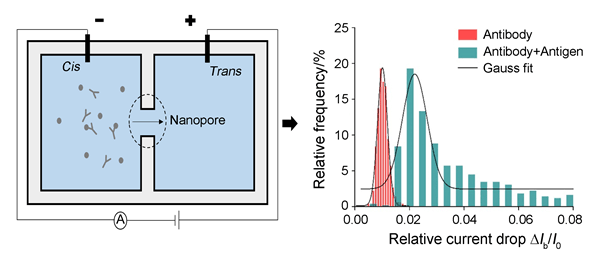| [1] Wang, J.-Y. Biochemistry 1, Higher Education Press, Beijing, 2002, pp. 123~124. (王镜岩, 生物化学, 上册, 高等教育出版社, 北京, 2002, pp. 123~124.)
[2] Li, C.-Y. Basic Immunology, Science Press, Beijing, 2012, pp. 35~39(in Chinese). (李春艳, 免疫学基础, 科学出版社, 北京, 2012, pp. 35~39.)
[3] Waduge, P.; Hu, R.; Bandarkar, P.; Yamazaki, H.; Cressiot, B.; Zhao, Q.; Whitford, P. C.; Wanunu, M. ACS Nano 2017, 11, 5706.
[4] Zhang, J.-Y.; Zhou, X.-Y.; Zhou, M.; Jia, H.-X. Acta Chim. Sinica 2016, 74, 513(in Chinese). (张佳玉, 周晓毓, 周曼, 贾红霞, 化学学报, 2016, 74, 513.)
[5] Deamer, D.; Akeson, M.; Branton, D. Nat. Biotechnol. 2016, 34, 518.
[6] Dekker, C. Nat. Nanotechnol. 2007, 2, 209.
[7] Howorka, S.; Cheley, S.; Bayley, H. Nat. Biotechnol. 2001, 19, 636.
[8] Meller, A.; Nivon, L.; Branton, D. Phys. Rev. Lett. 2001, 86, 3435.
[9] Nakane, J. J.; Akeson, M.; Marziali, A. J. Phys.-Condens. Matter 2003, 15, 1365.
[10] Storm, A. J.; Storm, C.; Chen, J. H.; Zandbergen, H.; Joanny, J. F.; Dekker, C. Nano Lett. 2005, 5, 1193.
[11] Ying, Y. L.; Cao, C.; Long, Y. T. Analyst 2014, 139, 3826.
[12] Oukhaled, A.; Bacri, L.; Pastoriza-Gallego, M.; Betton, J. M.; Pelta, J. ACS Chem. Biol. 2012, 7, 1935.
[13] Kasianowicz, J. J.; Brandin, E.; Branton, D.; Deamer, D. W. Proceedings of the National Academy of Sciences of the United States of America 1996, 93, 13770.
[14] Wendell, D.; Jing, P.; Geng, J.; Subramaniam, V.; Lee, T. J.; Montemagno, C.; Guo, P. Nat. Nanotechnol. 2009, 4, 765.
[15] Cao, C.; Liao, D.-F.; Ying, Y.-L.; Long, Y.-T. Acta Chim. Sinica 2016, 74, 734(in Chinese). (曹婵, 廖冬芳, 应佚伦, 龙亿涛, 化学学报, 2016, 74, 734.)
[16] Ma, J.; Qiu, Y. H.; Yuan, Z. S.; Zhang, Y.; Sha, J. J.; Liu, L.; Sun, L. T.; Ni, Z. H.; Yi, H.; Li, D. Y.; Chen, Y. F. Phys. Rev. E 2015, 92, 022719.
[17] Wang, Y.; Yu, X.-F.; Liu, Y.-Y.; Xie, X.; Cheng, X.-L.; Huang, S.-M.; Wang, Z.-M. Acta Chim. Sinica 2014, 72, 378(in Chinese). (王跃, 余旭丰, 刘芸芸, 谢骁, 程秀兰, 黄少铭, 王志民, 化学学报, 2014, 72, 378.)
[18] Jiang, Y.-N.; Guo, W. Sci. Bull. 2015, 60, 491.
[19] Guo, W.; Jiang, L. Sci. China Matter 2014, 57, 2.
[20] Su, B.; Guo, W.; Jiang L. Small 2015, 11, 1072.
[21] Wu, L.-Z.; Liu, Y.-Q.; Liu, W.; Chen, D.; Chen, H. Acta Biophys. Sinica 2014, 5, 360(in Chinese). (武灵芝, 刘玉棋, 刘伟, 陈栋, 陈豪, 生物物理学报, 2014, 5, 360.)
[22] Farimani, A. B.; Heiranian, M.; Min, K.; Aluru, N. R. J. Phys. Chem. Lett. 2017, 8, 1670.
[23] Freedman, K. J.; Jurgens, M.; Prabhu, A.; Ahn, C. W.; Jemth, P.; Edel, J. B.; Kim, M. J. Anal. Chem. 2011, 83, 5137.
[24] Niedzwiecki, D. J.; Grazul, J.; Movileanu, L. J. Am. Chem. Soc. 2010, 132, 10816.
[25] Ying, Y.-L.; Zhang, X.; Liu, Y.; Xue, M.-Z.; Li, H.-L.; Long, Y.-T. Acta Chim. Sinica 2013, 71, 44(in Chinese). (应佚伦, 张星, 刘钰, 薛梦竹, 李洪林, 龙亿涛, 化学学报, 2013, 71, 44.)
[26] Ying, Y.-L.; Long, Y.-T. Sci. Chi. Chem. 2017, 60, doi:10.1007/s11426-017-9082-5.
[27] Reiner, J. E.; Balijepalli, A.; Robertson, J. W. F.; Campbell, J.; Suehle, J.; Kasianowicz, J. J. Chem. Rev. 2012, 112, 6431.
[28] Saleh, O. A.; Sohn, L. L. Proc. Natl. Acad. Sci. U. S. A. 2003, 100, 820.
[29] Takakura, T.; Yanagi, I.; Goto, Y.; Ishige, Y.; Kohara, Y. Appl. Phys. Lett. 2016, 108, 123701.
[30] Alzghoul, S.; Hailat, M.; Zivanovic, S.; Que, L.; Shah, G. V. Biosens. Bioelectron. 2016, 77, 491.
[31] Kwak, D. K.; Chae, H.; Lee, M. K.; Ha, J. H.; Goyal, G.; Kim, M. J.; Kim, K. B.; Chi, S. W. Angew Chem., Int. Ed. 2016, 55, 5713.
[32] Wang, S.; Haque, F.; Rychahou, P. G.; Evers, B. M.; Guo, P. ACS Nano 2013, 7, 9814.
[33] Han, A.; Creus, M.; Schurmann, G.; Linder, V.; Ward, T. R.; de Rooij, N. F.; Staufer, U. Anal. Chem. 2008, 80, 4651.
[34] Freedman, K. J.; Bastian, A. R.; Chaiken, I.; Kim, M. J. Small 2013, 9, 750.
[35] Peters, T. Adv. Protein. Chem. 1985, 37, 161.
[36] Li, J. L.; Talaga, D. S. J. Phys.-Condens. Matter 2010, 22, 454.
[37] Ling, D. Y.; Ling, X. S. J. Phys.-Condens. Matter 2013, 25, 375102.
[38] Li, J. L.; Fologea, D.; Rollings, R.; Ledden, B. Protein and Peptide Letters. 2014, 21, 256.
[39] Deblois, R. W.; Bean, C. P. Rev. Sci. Instrum. 1970, 41, 909.
[40] Han, A. P.; Schurmann, G.; Mondin, G.; Bitterli, R. A.; Hegelbach, N. G.; de Rooij, N. F.; Staufer, U. Appl. Phys. Lett. 2006, 88, 093901.
[41] Larkin, J.; Henley, R. Y.; Muthukumar, M.; Rosenstein, J. K.; Wanunu, M. Biophys. J. 2014, 106, 696. |
